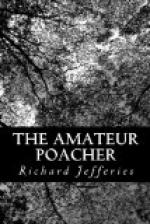There were houses of course somewhere in Essant, but they were so scattered that a stranger might doubt the existence of the village. A few farmsteads long distances apart, and some cottages standing in green lanes and at the corners of the fields, were nearly all; there was nothing resembling a ’street’—not so much as a row. The church was in effect the village, and the church was simply the mausoleum of the Dessant family, the owners of the place. Essant Hill as a name had been rather a problem to the archaeologists, there being no hill: the ground was quite level. The explanation at last admitted was that Essant Hill was a corruption of D’Essantville.
It seemed probable that the population had greatly diminished; because, although the church was of great antiquity, there was space still for interments in the yard. A yew tree of immense size stood in one corner, and was by tradition associated with the fortunes of the family. Though the old trunk was much decayed, yet there were still green and flourishing shoots; so that the superstitious elders said the luck of the house was returning.
Within, the walls of the church were covered with marble slabs, and the space was reduced by the tombs of the Dessants, one with a recumbent figure; there were two brasses level with the pavement, and in the chancel hung the faded hatchments of the dead. For the pedigree went back to the Battle of Hastings, and there was scarce room for more heraldry. From week’s end to week’s end the silent nave and aisles remained empty; the chirp of the sparrows was the only sound to be heard there. There being no house attached to the living, the holder could not reside; so the old church slumbered in the midst of the meadows, the hedges, and woods, day after day, year after year.
You could sit on the low churchyard wall in early summer under the shade of the elms in the hedge, whose bushes and briars came right over, and listen to the whistling of the blackbirds or the varied note of the thrush; you might see the whitethroat rise and sing just over the hedge, or look upwards and watch the swallows and swifts wheeling, wheeling, wheeling in the sky. No one would pass to disturb your meditations, whether simply dreaming of nothing in the genial summer warmth, or thinking over the course of history since the prows of the Norman ships grounded on the beach. If we suppose the time, instead of June, to be August or September, there would not even be the singing of the birds. But as you sat on the wall, by-and-by the pheasants, tame as chickens, would come up the hedge and over into the churchyard.
Leaving the church to stroll by the footpath across the meadow towards the wood, at the first gateway half-a-dozen more pheasants scatter aside, just far enough to let you pass. In the short dusty lane more pheasants; and again at the edge of the cornfield. None of these show any signs of alarm, and only move just far enough to avoid being trodden on. Approaching the wood there are yet more pheasants, especially near the fir plantations that come up to the keeper’s cottage and form one side of the enclosure of his garden. The pheasants come up to the door to pick up what they can—not long since they were fed there—and then wander away between the slender fir trunks, and beyond them out into the fields.




